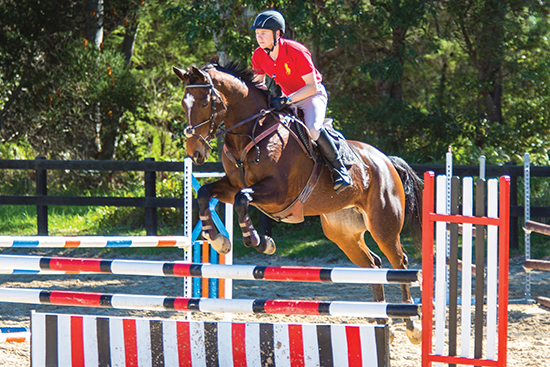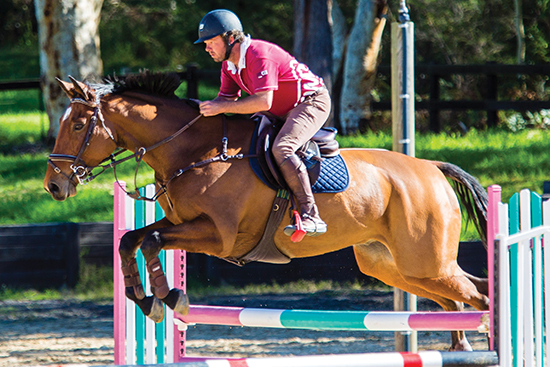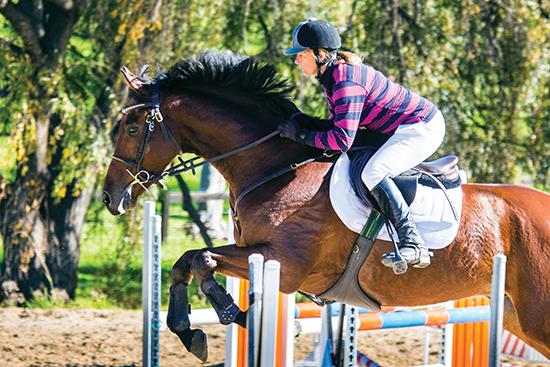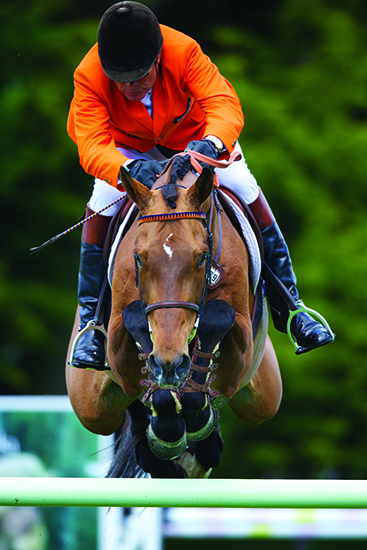
The controversial Dutch rider and trainer was the Australian showjumping coach in 1996-98, but he hasn’t taught in Australia since then – although he did return to Sydney in 2000 to take home an individual silver medal with Lando. At his Sydney Clinic, Albert showed that he had lost none of his drive, wit, or willingness to offer an unorthodox solution…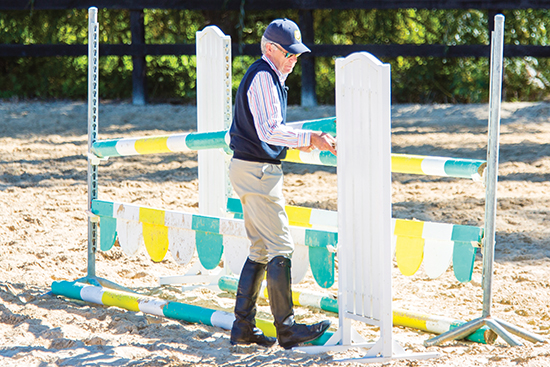
Albert had two groups at Heath and Krissy Harris’ Mt White property.
The jumps went higher but the theory remained the same. The older horses followed the exact same warm up as the younger ones earlier in the day and the riders still had to focus on their position, “The more open you are, the easier it is to control what you do. The more closed you are, the more exhausted you get and the harder it is to control everything.”
“The hand is a totally quiet hand with just the weight of the rein as the contact. Before you go into the light seat, make sure the horses are forward and in front of you or else you start holding with your calves and legs.”
James Mooney and Aaron Hadlow were both encouraged to hollow their lower back slightly. “Automatically it makes you sit lighter and straighter. Don’t flap your arms. Quiet. Hand quiet and spur to make him go to the hand. When we start flapping the arms, we lose the contact.”
When the circles around the jumps became smaller, Aaron’s mare Valinvader struggled a
little with the extra challenge in balance, but Albert kept it simple with not too much pressure on the horse, “Aaron, slow down stride by stride until you have the pace that is comfortable. It’s ok if she comes up in front. It’s not a problem because she needs that at the moment. As it becomes easier, she won’t lift her head.”
It was important to Voorn that the horses do the work and the riders just guide. Aaron was reminded of this, “With the inside leg, not a consistent pressure to the inside. I want her to carry you. Your leg is just there.”
Tess Geraghty and her Madison Square were also corrected, “The moment you feel it is difficult for the horse to do what you want, don’t get stronger, get lighter. Resist less without giving the rein away. The more you hold him together, the more he gets upset about it and wants to go. When he gets too tense, make the circle bigger.”
When it came to the jumping, it was obvious that the riders had been paying good attention to their trainer over the previous days and it was all starting to come together. Albert was especially pleased with clinic organiser Krissy Harris on Kitara Billecart despite a course error, “Krissy, you lost your way! No worries. I’m already happy that you ride well. I never want to hear the excuse anymore that you cannot ride Warmbloods. Even though you are small, you can ride Warmbloods. Cannot be better. Su-per!”
And then Albert turned to me, “Even from the airport Krissy was saying she cannot ride Warmbloods, she prefers Thoroughbreds, but with little corrections, we have changed that. He was pulling her down because she would pull the outside rein and squeeze with the thigh. Outside rein brings them down, inside flexion lets them come out.”
The final piece of advice for Aaron was simple, if not easy, “Have you ever seen videos of McLain Ward? Look and learn to sit like him and you’ll be perfect.”
Voorn aims for progression in stages; get one thing right then add the next. This guards against over facing the horses. James was on the right track getting Valkyrie to wait a little, “At the moment that you feel that he’s waiting for you, the more you can stay in a normal pace and the more they get confidence and you never create a big problem that you have to sort out. However, the smoother we get when we ride, sometimes the less attentive the horse gets. But, at the start you want the smoothness and to get good control. After that you can play with the sharpness.”
Distances were still a focus in the afternoon sessions and when Coco Dalhunty was struggling on Walaroo Carnivale, Albert explained why, “Because you don’t have the distance in your eye, you start to slow down. This is a shame. Maintain your canter. One more time. We are nearly there. Now, after five times the horse starts to slow down on his own. So then, keep the change and after a couple more times it will be right.”
“I see my distances really, really late. No one believes me. But this is why I sit and wait. This is why I won silver and not gold! I didn’t see the distance!” laughed the Olympian.
James Mooney and Valkyrie
There was more discussion on staying out of the horse’s way as a rider. The less the rider can do, the more beneficial it is to the horse. “Bindi (Torrens), you’re doing great. Big change. You’re not holding him together now. You’re allowing him to be. It is so less physical for you. Now you do a tenth of what you were doing in the first lesson and it’s a beautiful round with no argument from the horse. I give you ten out of ten.”
Not only will doing the least amount possible as a rider help, but also keeping things consistent on course. This results in less confusion for the horse. When Tess had a refusal, Albert guided her, “In your approach, maintain contact without moving your hand. Super. Don’t rush him forward and also don’t hesitate. It’s like yes, no, maybe. Instead just keep everything the same and the distance will show itself. See? I speak the truth. Nothing but the truth. Perfect.”
Albert really does speak the truth as he sees it. Some may argue against his ways, which can at times be left of centre, however, all the combinations improved over the clinic and I didn’t hear a bad word from any of the riders….or the horses – and we all know that horses never lie!
Why did you choose to host the clinic?
“Two reasons. He trained me in 1996/97 when he was the Australian coach and I had a very wild Thoroughbred called Mr Popeye and he was amazing with him. So, when Paula (Hamood) my best friend said she was bringing him out, I put my hand up and said I’d love to.”
How did your lessons go?
“I’ve had some massive improvements. I first of all have to thank Chris Chugg because he’s been giving me lessons and without his lessons I don’t think I would have been nearly as easy for Albert to teach, but I don’t know whether it’s mental or what it is, but I struggle with Warmbloods badly. I think because I’m short I can’t really do it, but he taught me a technique over the last three days that height doesn’t really matter. So I’m very, very happy. I think the main thing he wants, he doesn’t really focus on the “education” as much, he thinks the obedience is more important. So, where my horse would take four or five strides to go from walk to canter, Albert insists that he goes straight into canter. Once I have that, well then it’s a logical progression and when you put your leg on to go to a fence, he’s already forward. The same with the halt. It doesn’t matter where his head is, he must stop. In demanding the obedience, all of a sudden I have a horse I can ride. Then the rest of it happens later. Obedience first, education second. Thank you Albert!”
“Everybody has got something out of this clinic in the sense that Albert is so nice to deal with, and the amount of respect he has from all his students is just amazing. In return he respects us as riders and competitors. You could really, really see that over the last three days.”
Rebecca continues her extraordinarily frank interview with Albert:
Do you get other ideas and inspirations from the sports you follow?
Very much so. I have a big interest in the speed skating. I was a very talented speed skater and I had to make a choice what would I do. And the choice I made, horse riding, was because I could do this still when I was 60 years old, so I could be very much longer in the limelight! Very simple! haha. Why do we do sport or why do we do something? Because we like to be in the spotlight. And you know people retire and then suddenly they come back. Why do they do that? Because they miss the spotlight. They don’t miss running and getting fit. You can do that anywhere, but they miss being on the radio, the television, whatever. When you are good ,and you get a lot of attention, it’s like a drug.
What has been the main thing you’ve taken from speed skating?
The thing is, what I get out of it, I follow always the comments of trainers, how they train, what they do. Then you come to the conclusion, many mistakes are made by professional trainers because they over-train. They over-train and then the athlete can’t perform anymore. I’m a very logical thinker so sometimes certain things are very hard for me to understand. Things should be very simple. You have the very routine sport people that write their records in what they do. They have built up many training hours and then suddenly there comes this young bloke, this new young star that has maybe not even 10% of the training hours that they have and suddenly they get beaten by him. Then you start to doubt yourself. But these young, talented guys want to improve on what they do and they start different types of training and they start weight training or something and then finally they find out that the weight training makes them slower because you develop another muscle. So I say where is the knowledge of these trainers? How can these trainers over-train someone? Then you’re a bad trainer. And with the speed skating, because we are so good in our country, it happens a lot to the superstars.
So for me also, people say you need a coach. Why? I cannot understand why a tennis player like Roger Federer travels with a coach all the time because they say the same thing. So that means that you don’t take in what you’re told. So when I pay you $100 for information and you give me it, the thing is that I don’t forget it. And that’s why I don’t talk so much when my students ride a course. They make mistakes but I try to let them figure it out because as a trainer if we repeat and repeat and repeat, then the rider doesn’t think anymore. For me, giving information is trying to create independency for the person that gets it. You go to school to learn a trade and finally you know your trade and you do your trade. You don’t go to school until you’re 90, no?
So when I’m a tennis player and I play a match and Nadal beats me, then I watch the game. I go and sit down, take a nice drink and I analyse it; I see the parts where I have to pay attention. When I train at home and I have a new horse or whatever, very regularly, my wife tapes. Then in the evening I watch my tape and I think, ‘Reins too long, too slow, not straight in the middle.’ It stops me getting slack. I am highly critical of myself because, who’s going to teach me first of all, because the one that is on the ground does not know what I’m looking for.
Albert and Taballo, third at the Dutch Championship 2013
I can go to somebody when I have a real problem I cannot solve like I did when I went to Ian Millar. I think, “Who do I think can help me solve this problem?’ Because we are professionals we don’t charge each other. We are actually proud and honoured that one of our colleagues who is as good as the other will ask to solve a problem. We spent the afternoon with this particular horse and we had ideas and tried this and that. Then this person, with me thinking black, shows me that thinking white for this particular animal is better; shows me that this works. So instantly I change from black to white. I’m not going, ‘Yes, but maybe we make it grey.’ It’s white because he showed me that it is white.
It’s very easy when you ride a clear round and you sit in front of the television and you watch yourself on video and you think, ‘I’m great! I’m really good!’ You know? But then you still have to think about it or else you get slack.
That is also another thing, and why it is so important with the teaching when you have like you saw the two sisters that are insecure. First of all I always give a lot of compliments. ‘Super’, ‘Very good’, because high performance is based on self confidence. The moment that you doubt, it is the enemy of your performance. So first of all I have a student I have to open up a bit. Their first impression is that I’m a bit strict. But then you start to compliment and talk quietly, which is why I like to teach with the microphone and headset so I can talk very quietly. Then they think, ‘Hmmm, he’s much nicer than I thought he’d be. He’s actually very nice!’ Then when you give them information, they do not see it so much as being confronted about what they do wrong.
So as a trainer, it is very important that you reach the person so they open up for the information that you want to give them. Very, very important. The moment I teach people and they don’t get what I want them to get, I’m not blaming the person, I’m always questioning which other words, which other approach, which other thing can I use to make it work. Because then I teach 18 combinations here, I want them all to say how great I am! Finally that is an achievement, that they walk away and think, ‘Wow, we had such a great time. What a great guy!’ Of course you cannot convince everybody, but I want to walk away knowing that for that particular person, they received the maximum satisfaction out of the three days that they are investing in. That is the idea I have about my teaching.
But then finally let’s say, if you want to be very successful in life, in no matter what you’re doing first it comes from being extremely selfish. And the moment that you live with another person and even when that person does agree from the time you start to live together that you are the priority in life, there comes a point this person does not accept it anymore. That’s why people divorce.
But you didn’t divorce.
No I didn’t because I always adapted myself to the situation. I’ve never told other people to do that to me.
Would you change anything about your life now though?
I would have liked for me to just have two horses and a truck and travel around the shows but no, I am a person who takes the consequences of the decisions that I make. The thing is that I’m going to change it but I’m not allowed to change it as long as I have my property. I need a customer.
But you run your stables with your son?
No, we have no contact anymore. We have not been on speaking terms for one year. We created a beautiful house, a nice yard, everything. The financial picture is made for his income and my income. To help him with his future, to support him, I gave up my riding career. To give that is me giving everything up to help someone else. Now he bought another place with the money of an owner and leaves his mother and me behind and now we are forced to sell our place. So, I am not very grateful of that matter. And it has broken my heart in so many pieces that the glue to find to heal it does not exist yet. People say ‘It’s your son’ and this and that. I don’t care. I don’t want to be treated like a piece of shit. If he would have said, ‘Dad, listen, I’ve decided differently, I have a different opportunity, but I’ll make sure by the end of the year, you are in a situation that you can cover the expenses that you made,’ then he would be a man, but you just don’t walk out and leave your parents behind like a piece of shit, especially when you are 30 years old. When you are 18 and do that, you’re not expected to have brains.
Who have been your main influences in riding?
The main influence that changed my life was Ian Millar. And then you have other people. Let’s say when I started riding, my example for style over the fence was Eddie Macken. Then the flat work was Franke Sloothaak in the time that he was working with Alwin Schockemöhle. Now not anymore because in my opinion he has totally changed. Today when I see his work I do not like it at all. They were the three people.
Then you know in the way of thinking, the way of approaching, Monty Roberts.
You did some demonstrations with Monty too?
Yes but not anymore. He did some with Anky and she would do a flying change then he would do a flying change and so on.
Already he was behind me because he cannot jump with one hand. So, because I was asked and I gave into it, we made the best out of it. But, when you give a lecture/ demonstration and people come to watch, it’s an education thing for the people. That is what it should be. It should not be a demonstration about how good one is. When that is the attitude, that is what I don’t like, you understand?
Then he wanted to do it again at the Nations Cup in Rotterdam. I said I would do it, but on my terms otherwise I don’t do it because it did not interest me in the way he does it. They came back to me with the answer, ‘No problem, he will fit in’. I had a chat with him before because I wanted to show the people the comparison between the western riding, why the reins in one hand, why this, why that. He was riding his Quarter horse and I was riding my horse, then we gave a totally different demonstration. It was not about who can do the best one thing, but about why do we do what we do. Perfect! But, then one doesn’t stand out because you’re on equal level. That was difficult for him, a person with his name. Then he said, ‘I have the Monty Roberts University. Would you like to take part in that?’ and I said maybe, yes. It depends. Then I never heard anymore about it.
But you said earlier that you like to show off yourself?
Yes but the thing is, the show off should never be, let’s say, it comes more out of the fact that people say, ‘Wow, amazing. The knowledge. A solution for the problem,’ not because of the tricks. Can you understand?
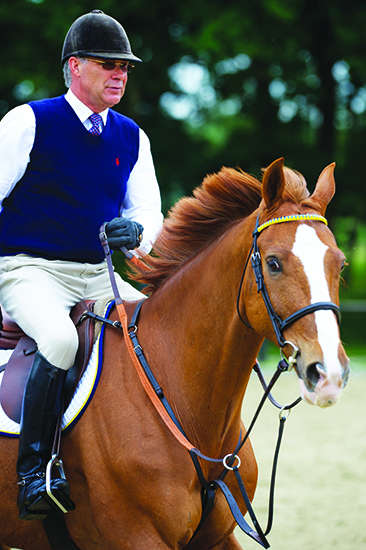 Absolutely. So why DO you ride one handed?
Absolutely. So why DO you ride one handed?
It gives the rider the opportunity to totally relax. With the two hands we tend to do much more due to the fact that we do more than we should. It creates a lot of tension. The reason why western riders ride one handed is due to the fact that they have to use the lasso. So the idea of riding with one hand is a totally different idea. I started riding with one hand after watching a training video of western riding. I was bored at a show and I started watching and I thought, ‘It looks well, it works well, I’m going to try it.’ So, I got it from them but for a different reason.
I like to watch everything because every trainer, no matter who he is, thinks that what he does is the best thing. Because if he didn’t think so, he would do something else. And I particularly think like that. But, to stay the best in what I do, I cannot have it that somebody else does something better than me, so even when I’ve done 20 years a certain kind of thing, if I see somebody doing something that is much better than what I do, it works quicker, faster, easier, less aggravation with the animal, I forget what I did for 20 years because I didn’t know better and I do straight away the new thing.
That is the thing, you have to stay sharp. In general, we are so set in our ways, that we get closed minded and that is definitely what I always look at. No matter how much I think how brilliant I am, I say that not to sound arrogant, but I want people to know, no matter how good you think you are, can we stay up with the best? So when there is a new invention, when there is a way that works better, bang, I change. I don’t want to lose out to the others.
You are known to work well with difficult horses. Do you prefer them?
At the end of the day as professional riders, we have to be able to deal with what we get, and we have to get the best out of it. My preference is to have the easiest horse that wins all the classes! The more complicated they are, the harder it is to win. But when there is a difficult one, it’s nice if you can come to the point that you can make it competitive and that you can make it work.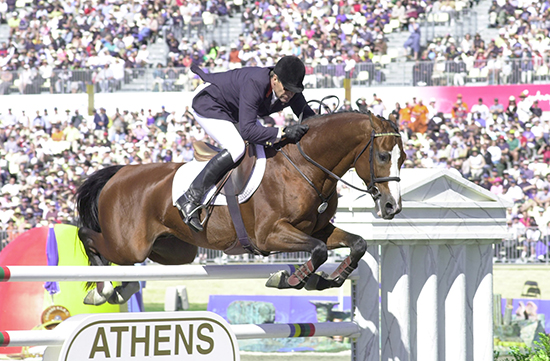
Albert and Lando
Who was your greatest horse? Lando?
No. Jewels Amethyst. I rode him in the years 1993-95. He died two weeks ago at the age of 30. Of course Lando gave me a result that is known worldwide. It was an important result, but winning a silver medal in my opinion does not come close to a championship achievement. The Olympic medal you win on a two round course. When you’re luckier than the others, then you have a chance to win, but when you are in a championships and you have to ride over three days, five rounds or so, I think that achievement is more remarkable than anything else. I think there is too much importance placed on Olympic Games for our sport.
At the end of the day, the goal of each rider is to be a leading rider worldwide on a consistent basis. That is actually what it’s all about. It is not just a one time performance and I have not been able to achieve that, because let’s say, I have a way of thinking and a way of doing my things that is not liked by everybody. For that reason I have not been able to create a consistent situation where I was provided with horses that can give you that lead.
But if you are not cruel to your horses and you are winning on a horse, why would owners not want you to ride them?
When you have owners with high budgets, they have a tendency to be disrespectful of the person who works for them, or rides for them. And for me in life, the priority is mutual respect. When that is not there in the way that I expect it to be, there is a problem. Also I am confrontational because I say what I think. It doesn’t matter who it is. If Princess Haya makes me wait one and a half hours, I don’t wait. I don’t wait for anybody. Neither the King of Holland. They either call me to tell me they are late, and if they think that because they are the king that they can make me wait, then we have a situation that I don’t accept. I stand for that. If that costs me a good horse, then it does.
You were involved with racing a bit too, weren’t you?
Yeah I had a trainer’s license. I spent three years trying to combine it with the showjumping but it was impossible.
But showjumping is your love?
No. If today I would or could make a small living off training racehorses, that is the thing I love most. But before owners decide to give you horses to train, you have to prove yourself. I wanted to quit totally the showjumping in 1999, so I tried to get a job in a racing stable to be the assistant of the assistant of the assistant trainer, you know? Everybody said there is no problem, we would love to have you here tomorrow, but the place I was looking at, they had so many people waiting in their stable who came from the first day and worked their way up, it would not have been respectful of me. That is the reason that I couldn’t find a job and then suddenly the phone call came about Lando so I started to ride Lando.
So have you given up on the dream of a truck and two horses?
That is the aim ‘til I die. But one step at a time. Now I put my property up for sale at a price which already I would lose 800,000 Euros. And still there is no interest. So the moment I sell my place, I’ll have empty pockets, but no debts, then I’ll be the happiest person there is, though I lost a tremendous amount of money. And I don’t even mind that. But if I can then live the life that I always wanted to live as a young person, I’ve succeeded, because if I’m today broke but with no debts, at the end of the day I have money in my pocket. I give a clinic and I live.
More from Albert and part one of this article here:



